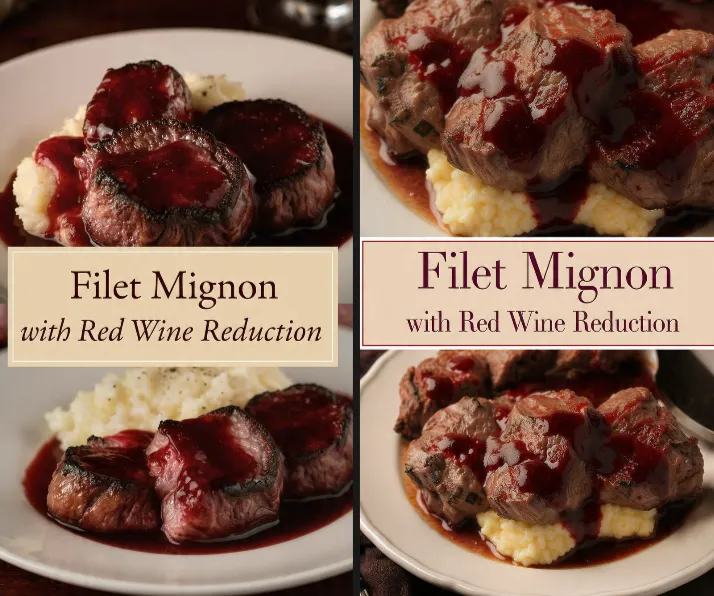Filet mignon with red wine reduction is the epitome of fine dining at home. This dish combines the buttery tenderness of filet mignon with the deep, complex flavors of a red wine reduction sauce. The result is a perfectly seared steak coated in a glossy, savory sauce that elevates every bite. It’s a meal that feels luxurious yet approachable, ideal for romantic dinners, celebrations, or when a touch of elegance is desired.
The beauty of this recipe lies in its simplicity — high-quality beef, a hot pan, and a rich sauce made from wine, shallots, and butter. The flavors are balanced, the textures are indulgent, and the presentation is stunning.
The Essence of Filet Mignon with Red Wine Reduction
Filet mignon is one of the most tender cuts of beef, taken from the smaller end of the tenderloin. It’s prized for its buttery texture and mild flavor, which makes it the perfect canvas for a bold, flavorful sauce. The red wine reduction adds depth and richness, complementing the steak without overpowering it.
This dish embodies the essence of French-inspired cooking — simple ingredients, precise technique, and a focus on balance. The seared crust of the filet contrasts beautifully with the silky sauce, creating a dish that’s both comforting and refined.
Why This Recipe Works
This recipe works because it focuses on technique and timing. The filet mignon is seared to perfection, locking in juices and creating a golden crust. The red wine reduction is simmered slowly to concentrate flavors, then finished with butter for a velvety texture. Together, they create a harmonious dish that’s rich, elegant, and deeply satisfying.
The result is a restaurant-quality meal that’s surprisingly easy to make at home.
Ingredients and Their Roles
Filet mignon steaks: The star of the dish, tender and buttery.
Salt and black pepper: Essential for seasoning and enhancing flavor.
Olive oil and butter: Used for searing and adding richness.
Shallots: Add sweetness and depth to the sauce.
Garlic: Provides aromatic flavor.
Red wine: The base of the reduction, adding acidity and complexity.
Beef stock: Adds body and richness to the sauce.
Fresh herbs (thyme or rosemary): Infuse the sauce with fragrance.
Step-by-Step Recipe
Ingredients
- 2 filet mignon steaks (about 6 ounces each, 1 ½ inches thick)
- 1 tablespoon olive oil
- 2 tablespoons butter, divided
- Salt and freshly ground black pepper, to taste
- 1 shallot, finely chopped
- 1 clove garlic, minced
- ¾ cup dry red wine (Cabernet Sauvignon or Merlot)
- ½ cup beef stock
- 1 teaspoon fresh thyme leaves (or 1 sprig thyme)
Preparation
- Prepare the steaks. Remove the filet mignon from the refrigerator 30 minutes before cooking. Pat dry with paper towels and season generously with salt and pepper.
- Sear the steaks. Heat olive oil and 1 tablespoon butter in a heavy skillet (preferably cast iron) over medium-high heat. When the pan is hot, add the steaks and sear for 3–4 minutes per side for medium-rare, or until the internal temperature reaches 130°F (54°C). Adjust cooking time based on desired doneness.
- Rest the steaks. Transfer the steaks to a plate and cover loosely with foil. Let them rest while preparing the sauce.
- Make the red wine reduction. In the same skillet, add the chopped shallot and garlic. Sauté for 1–2 minutes until fragrant and softened.
- Deglaze the pan. Pour in the red wine, scraping up any browned bits from the bottom of the pan. Add the thyme and simmer for 5–7 minutes, until the liquid reduces by half.
- Add the stock. Pour in the beef stock and continue simmering for another 5 minutes, until the sauce thickens slightly.
- Finish with butter. Remove the pan from heat and whisk in the remaining tablespoon of butter to create a glossy, velvety sauce.
- Serve. Spoon the red wine reduction over the filet mignon and garnish with fresh herbs.
Tips for Perfect Filet Mignon with Red Wine Reduction
- Use high-quality beef for the best flavor and texture.
- Pat the steaks dry before searing to ensure a crisp crust.
- Don’t overcrowd the pan; sear in batches if necessary.
- Let the sauce reduce slowly for concentrated flavor.
- Rest the steak before serving to retain juices.
Variations and Flavor Combinations
1. Classic Filet Mignon with Red Wine Reduction
Traditional version with shallots, garlic, and thyme.
2. Mushroom Red Wine Sauce
Add sautéed mushrooms to the sauce for earthiness.
3. Balsamic Red Wine Reduction
Add a splash of balsamic vinegar for sweetness and tang.
4. Peppercorn Filet Mignon
Add crushed peppercorns for a spicy kick.
5. Blue Cheese Filet Mignon
Top with crumbled blue cheese for a rich, tangy finish.
6. Rosemary and Garlic Filet Mignon
Infuse the butter with rosemary and garlic for extra aroma.
Serving Suggestions
Filet mignon with red wine reduction pairs beautifully with:
- Mashed potatoes or truffle mashed potatoes.
- Roasted asparagus or green beans.
- Creamed spinach or sautéed mushrooms.
- Garlic butter noodles or risotto.
- A glass of red wine, such as Cabernet Sauvignon or Pinot Noir.
Make-Ahead and Storage
Make-ahead: Prepare the red wine reduction in advance and reheat gently before serving.
Storage: Store leftover steak and sauce separately in airtight containers in the refrigerator for up to 2 days.
Reheating: Reheat gently in a skillet over low heat to preserve tenderness.
Freezing: Not recommended, as the sauce may separate when thawed.
Nutritional Information (per serving)**
- Calories: 480 kcal
- Protein: 38 g
- Fat: 32 g
- Carbohydrates: 4 g
- Sugar: 1 g
The History of Filet Mignon
Filet mignon, meaning “dainty fillet” in French, has long been associated with fine dining and luxury. It comes from the tenderloin, one of the least-used muscles in the cow, which gives it its signature tenderness. The cut gained popularity in French cuisine during the 19th century and quickly became a staple in steakhouses around the world.
Paired with a red wine reduction, filet mignon embodies the elegance of French cooking — simple ingredients elevated through technique and balance.
Texture and Flavor Profile
The perfect filet mignon is tender, buttery, and melts in the mouth. The red wine reduction adds a layer of complexity, with notes of fruit, herbs, and caramelized shallots. The sauce’s acidity balances the richness of the steak, creating a harmonious bite that’s both luxurious and satisfying.
Each bite delivers contrast — crisp seared edges, tender interior, and a silky sauce that ties everything together.
Common Mistakes and How to Avoid Them
Overcooking the steak: Makes it dry. Use a thermometer for accuracy.
Skipping the rest period: Causes juices to run out. Always rest before serving.
Using cold steak: Leads to uneven cooking. Bring to room temperature first.
Boiling the sauce: Reduces flavor. Simmer gently for a smooth texture.
Adding butter too early: Causes separation. Add at the end for a glossy finish.
Chef’s Tips
- Choose a dry red wine like Cabernet Sauvignon or Merlot for depth.
- Use unsalted butter to control seasoning.
- Add a sprig of thyme or rosemary while the sauce simmers for aroma.
- Strain the sauce for a smooth, restaurant-style finish.
- Serve on warm plates to keep the steak hot.
Pairing Ideas
With Drinks:
- Cabernet Sauvignon or Merlot.
- Pinot Noir for a lighter pairing.
- Sparkling water with lemon for a refreshing contrast.
With Other Dishes:
- Pair with roasted potatoes or gratin dauphinois.
- Serve alongside a crisp green salad.
- Include in a multi-course dinner with soup or dessert.
The Joy of Fine Dining at Home
Filet mignon with red wine reduction brings the elegance of a steakhouse into the home kitchen. The process of searing the steak, deglazing the pan, and watching the sauce reduce is both satisfying and rewarding. The aroma of wine and herbs filling the kitchen sets the stage for a memorable meal.
It’s a dish that feels indulgent yet achievable, perfect for impressing guests or treating yourself to something special.
The Science of Red Wine Reduction
The magic of a red wine reduction lies in evaporation and concentration. As the wine simmers, the alcohol cooks off, leaving behind concentrated flavors of fruit, tannins, and acidity. The addition of beef stock adds body, while butter emulsifies the sauce, giving it a silky texture. The result is a sauce that’s rich, balanced, and perfectly complements the steak.
Presentation and Finishing Touches
For an elegant presentation, serve the filet mignon on a warm plate with the red wine reduction drizzled over the top. Garnish with fresh thyme or parsley for color. Add a side of mashed potatoes or roasted vegetables for a complete meal.
For a restaurant-style touch, spoon the sauce in a circular pattern around the steak and finish with a sprinkle of flaky sea salt.
Modern Variations
- Keto Filet Mignon: Naturally low-carb and high in protein.
- Gluten-Free Version: Naturally gluten-free when using gluten-free stock.
- Dairy-Free Version: Use olive oil instead of butter.
- Sous Vide Filet Mignon: Cook sous vide for precision, then sear and serve with the sauce.
- Filet Mignon with Port Wine Reduction: Substitute red wine with port for a sweeter, richer sauce.
The Perfect Dinner
Filet mignon with red wine reduction is the ultimate dinner for special occasions. It’s elegant, flavorful, and surprisingly easy to prepare. The combination of tender steak and rich sauce makes it a timeless classic that never fails to impress.
It’s also versatile — pair it with simple sides for a cozy dinner or elevate it with gourmet accompaniments for a fine dining experience.
The Cultural Influence of Filet Mignon
Filet mignon represents the pinnacle of refined dining, blending French culinary tradition with modern simplicity. The red wine reduction reflects the French philosophy of using wine to enhance flavor and create balance. Today, this dish is enjoyed worldwide as a symbol of sophistication and indulgence.
The Role of Red Wine
Red wine is the heart of the sauce, providing acidity, depth, and complexity. As it reduces, it transforms from sharp and fruity to rich and velvety. The choice of wine matters — a full-bodied red like Cabernet Sauvignon or Merlot works best, complementing the steak’s richness without overpowering it.
The Perfect Bite
The perfect bite of filet mignon with red wine reduction combines tender, buttery steak with a glossy, flavorful sauce. The flavors are balanced — savory, slightly sweet, and deeply aromatic — while the textures create a luxurious mouthfeel. It’s a dish that delights the senses and feels both comforting and refined.
Conclusion
Filet mignon with red wine reduction is a celebration of elegance, flavor, and technique. With its tender steak, rich sauce, and perfect balance of textures, it’s a dish that transforms any meal into a special occasion.
Quick to prepare yet impressive to serve, this recipe is perfect for date nights, holidays, or whenever a touch of luxury is desired. Whether paired with mashed potatoes, roasted vegetables, or a glass of red wine, it proves that great food doesn’t need to be complicated — just quality ingredients, careful preparation, and a touch of care.






